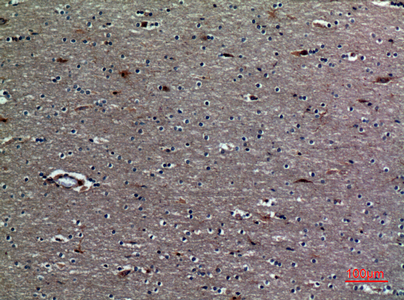TREM-1 Polyclonal Antibody
- Catalog No.:YT5133
- Applications:WB;IHC;IF;ELISA
- Reactivity:Human;Mouse
- Target:
- TREM-1
- Gene Name:
- TREM1
- Protein Name:
- Triggering receptor expressed on myeloid cells 1
- Human Gene Id:
- 54210
- Human Swiss Prot No:
- Q9NP99
- Mouse Gene Id:
- 58217
- Mouse Swiss Prot No:
- Q9JKE2
- Immunogen:
- Synthesized peptide derived from TREM-1 . at AA range: 40-120
- Specificity:
- TREM-1 Polyclonal Antibody detects endogenous levels of TREM-1 protein.
- Formulation:
- Liquid in PBS containing 50% glycerol, 0.5% BSA and 0.02% sodium azide.
- Source:
- Polyclonal, Rabbit,IgG
- Dilution:
- WB 1:500-2000;IHC 1:100-500;IF ICC 1:100-500;ELISA 1:5000-20000
- Purification:
- The antibody was affinity-purified from rabbit antiserum by affinity-chromatography using epitope-specific immunogen.
- Concentration:
- 1 mg/ml
- Storage Stability:
- -15°C to -25°C/1 year(Do not lower than -25°C)
- Other Name:
- TREM1;Triggering receptor expressed on myeloid cells 1;TREM-1;Triggering receptor expressed on monocytes 1;CD354
- Observed Band(KD):
- 26kD
- Background:
- triggering receptor expressed on myeloid cells 1(TREM1) Homo sapiens This gene encodes a receptor belonging to the Ig superfamily that is expressed on myeloid cells. This protein amplifies neutrophil and monocyte-mediated inflammatory responses triggered by bacterial and fungal infections by stimulating release of pro-inflammatory chemokines and cytokines, as well as increased surface expression of cell activation markers. Alternatively spliced transcript variants encoding different isoforms have been noted for this gene.[provided by RefSeq, Jun 2011],
- Function:
- function:Stimulates neutrophil and monocyte-mediated inflammatory responses. Triggers release of pro-inflammatory chemokines and cytokines, as well as increased surface expression of cell activation markers. Amplifier of inflammatory responses that are triggered by bacterial and fungal infections and is a crucial mediator of septic shock.,induction:Up-regulated by bacteria, fungi and lipopolysaccharides (LPS).,PTM:Glycosylated.,similarity:Contains 1 Ig-like V-type (immunoglobulin-like) domain.,subunit:Interacts with TYROBP/DAP12.,tissue specificity:Highly expressed in adult liver, lung and spleen than in corresponding fetal tissue. Also expressed in the lymph node, placenta, spinal cord and heart tissues. Expression is more elevated in peripheral blood leukocytes than in the bone marrow and in normal cells than malignant cells. Expressed at low levels in the early development of the hema
- Subcellular Location:
- [Isoform 1]: Cell membrane ; Single-pass type I membrane protein . Recruited to lipid rafts when activated. .; [Isoform 2]: Secreted .
- Expression:
- Mostly expressed by immune cells of the myeloid lineage, such as monocytes, macrophages, neutrophils and dendritic cells (PubMed:10799849). Expression is associated with a mature stage of myeloid development (PubMed:11922939). Highly expressed in adult liver, lung and spleen than in corresponding fetal tissue. Also expressed in the lymph node, placenta, spinal cord and heart tissues. Isoform 2 was detected in the lung, liver and mature monocytes.
Salmonella effector SpvB aggravates dysregulation of systemic iron metabolism via modulating the hepcidin−ferroportin axis. Gut Microbes Gut Microbes. 2021;13(1):1-18 WB Mouse Liver
Quercetin Alleviates LPS-Induced Depression-Like Behavior in Rats via Regulating BDNF-Related Imbalance of Copine 6 and TREM1/2 in the Hippocampus and PFC. Frontiers in Pharmacology Front Pharmacol. 2020 Jan;0:1544 WB Rat 1:1000 hippocampus,prefrontal cortex (PFC)
Downregulation of triggering receptor expressed on myeloid cells 1 inhibits invasion and migration of liver cancer cells by mediating macrophage polarization. ONCOLOGY REPORTS Oncol Rep. 2021 Apr;45(4):1-12 IHC,IF,WB Human 1:200,1:1000 Hepatocellular carcinoma (HCC)tissue ,Liver HepG2 cell,MHCC97H cell
Potential value of Interleukin-6 as a diagnostic biomarker in human MDD and the antidepressant effect of its receptor antagonist tocilizumab in lipopolysaccharide-challenged rats. INTERNATIONAL IMMUNOPHARMACOLOGY Jinfang Ge WB Rat 1:1000 hippocampus
Potential Role of Bmal1 in Lipopolysaccharide-Induced Depression-Like Behavior and its Associated Journal of Neuroimmune Pharmacology Xu Dan-Dan WB Rat,Mouse 1:1000 hippocampus,hypothalamus BV2 cell
- June 19-2018
- WESTERN IMMUNOBLOTTING PROTOCOL
- June 19-2018
- IMMUNOHISTOCHEMISTRY-PARAFFIN PROTOCOL
- June 19-2018
- IMMUNOFLUORESCENCE PROTOCOL
- September 08-2020
- FLOW-CYTOMEYRT-PROTOCOL
- May 20-2022
- Cell-Based ELISA│解您多样本WB检测之困扰
- July 13-2018
- CELL-BASED-ELISA-PROTOCOL-FOR-ACETYL-PROTEIN
- July 13-2018
- CELL-BASED-ELISA-PROTOCOL-FOR-PHOSPHO-PROTEIN
- July 13-2018
- Antibody-FAQs
- Products Images

- Western Blot analysis of THP-1, mouse heart cells using TREM-1 Polyclonal Antibody. Secondary antibody(catalog#:RS0002) was diluted at 1:20000

- Immunohistochemical analysis of paraffin-embedded human-brain, antibody was diluted at 1:100


